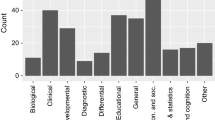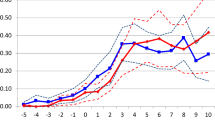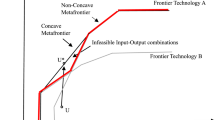Abstract
The literature dedicated to the analysis of the difference in research productivity between the sexes tends to agree in indicating better performance for men. Through bibliometric examination of the entire population of research personnel working in the scientific-technological disciplines of Italian university system, this study confirms the presence of significant differences in productivity between men and women. The differences are, however, smaller than reported in a large part of the literature, confirming an ongoing tendency towards decline, and are also seen as more noticeable for quantitative performance indicators than other indicators. The gap between the sexes shows significant sectorial differences. In spite of the generally better performance of men, there are scientific sectors in which the performance of women does not prove to be inferior.
Similar content being viewed by others
References
Abramo, G., D’Angelo, C. A. (2007), Measuring science: Irresistible temptations, easy shortcuts and dangerous consequences. Current Science, 6: 762–766.
Abramo, G., D’Angelo, C. A., Pugini, F. (2008), The measurement of Italian universities’ research productivity by a non parametric-bibliometric methodology. Scientometrics, 76: 2.
Blackburn, R. T., Behymer, C. E., Hall, D. E. (1978), Research notes: Correlates of faculty publication. Sociology of Education, 51: 132–141.
Bonaccorsi, A., Daraio, C. (2003), Age effects in scientific productivity. The case of the Italian National Research Council (CNR), Scientometrics, 58(1): 49–90.
CIVR (2006), Comitato di indirizzo per la Valutazione della Ricerca, Valutazione Triennale della Ricerca Italiana: VTR 2001-2003, http://vtr2006.cineca.it.
Cole, J. R., Zuckerman, H. (1984), The productivity puzzle: persistence and change in patterns in publication of men and women scientists. Advances in Motivation and Achievement, 2: 217–258.
Dickson, V. A. (1983), The determinants of publication rates of faculty members at a canadian university. Canadian Journal of Higher Education, 13(2): 41–49.
Fox, M. F. (1983), Pubblication productivity among scientists: a critical review. Social Studies of Science, 13(2): 285–305.
Fox, M. F. (2005), Gender, family characteristics, and publication productivity among scientists. Social Studies of Science, 35(1): 131–150.
Gander, J. P. (1999), Faculty gender effects on academic research and teaching. Research in Higher Education, 40(2): 171–184.
Hyde, J. S., Linn, M. C. (1988), Gender differences in verbal ability: A meta-analysis, Psychological Bulletin, 104: 53–69.
Hyde, J. S., Fennema, E., Lamon, S. J. (1990), Gender differences in verbal ability: A meta-analysis, Psychological Bulletin, 107: 139–155.
Kyvik, S. (1990), Motherhood and scientific productivity. Social Studies of Science, 20: 149–160.
Leahey, E. (2006), Gender differences in productivity: research specialization as a missing link. Gender and Society, 20(6): 754–780.
Lee, S., Bozeman, B. (2005), The Impact of Research Collaboration on Scientific Productivity, Social Studies of Science, 35(5): 673–702.
Lemoine, W. (1992), Productivity patterns of men and women scientists in Venezuela, Scientometrics, 24(2): 281–295.
Linn, M. C., Peterson, A. C. (1985), Emergence and characterisation of sex differences in spatial ability: A meta-analysis, Child Development, 56: 1479–1498.
Long, J. S. (1987), Problems and Prospects for Research on Sex Differences in the Scientific Career. In: L. S. Dix (Ed.), Women: Their Underrepresentation and Career Differentials in Science and Engineering, National Academy Press. 157–169.
Moed, H. F. (2002), The impact factors debate: the ISI’s uses and limits. Nature, 415, 731–732.
Moravcsik, M. J. (1985), Applied scientometrics: an assessment methodology for developing countries. Scientometrics, 7(3–6): 165–176.
Pripić, K. (2002), Gender and productivity differentials in science. Scientometrics, 55(1): 27–58.
Ramsden, P. (1994), Describing and explaining research productivity. Higher Education, 28: 207–226.
Stack, S. (2004), Gender, Children and research Productivity. Research in Higher Education, 45(8) 891–920.
UE, (2006), Women and science-statistic indicators, SHE FIGURES 2006
Voyer, D., Voyer, S., Bryden, M. P. (1995), Magnitude of sex differences in spatial ability: A meta-analysis and consideration of critical variables, Psychological Bulletin, 117: 250–270.
Weingart, P. (2004), Impact of bibliometrics upon the science system: inadvertent consequences? In: H. F. Moed, W. Glänzel, U. Schmoch (Eds), Handbook on Quantitative Science and Technology Research. Dordrecht (The Netherlands), Kluwer Academic Publishers.
Xie, Y., Shauman, K. A. (1998), Sex differences in research productivity: new evidence about an old puzzle. American Sociological Review, 63: 847–870.
Xie, Y., Shauman, K. A. (2003), Women in Science: Career Processes and Outcomes, Harvard University Press, Cambridge, Massachusetts, and London, England.
Xie, Y., Shauman, K. A. (2004), Women in science: career processes and outcomes (review), Social Forces, 82(4): 1669–1671.
Zainab, A. N. (1999), Personal, academic and departmental correlates of research productivity: a review of literature. Malaysian Journal of Library & Information Science, 4(2): 73–110.
Author information
Authors and Affiliations
Corresponding author
Rights and permissions
About this article
Cite this article
Abramo, G., D’Angelo, C.A. & Caprasecca, A. Gender differences in research productivity: A bibliometric analysis of the Italian academic system. Scientometrics 79, 517–539 (2009). https://doi.org/10.1007/s11192-007-2046-8
Received:
Published:
Issue Date:
DOI: https://doi.org/10.1007/s11192-007-2046-8




